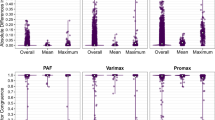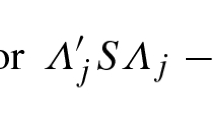Abstract
This paper thematise the problem of seeking and devising a simple structure, when the solution envisages the extraction of more than one component or factor. To this avail, we shall make a comparison between a number of rotation techniques, both orthogonal and oblique, to evaluate just how capable they are of delivering the highest possible semplification of the data yielded by the analysis. To evaluate the results obtained through empirical controls, we have drawn up a simple structure index. For reasons of space, we shall apply principal components analysis to our method, although the results obtained here also hold for factor analysis.

Similar content being viewed by others
Notes
This determines the circumstance that the sum of the squared component loadings in a row of the component matrix is never equal to the communality, except by chance. Similarly, only by chance the sum of the squared component loadings in the columns is equal to the total variance of the matrix.
In SPSS for Windows the number of steps of the Promax procedure can be set by means of a K parameter. The latter is set at 4 by default: by increasing that value, the number of steps is increased, and, as a result, the correlation between the components is also increased. The minimun possible value for K is 1, which entails low correlations between components. Originally, Hendrickson and White (1964) proposed a coefficient b which worked like the delta of the Direct Oblimin (see below) in that it enabled researchers to establish the desired angle between components or factors.
According to Kline, “using Direct Oblimin is generally recommended. However, it is good practice to use several rotation methods since no method guarantees not being deceived by specific data patterns. In most cases differences will not be relevant. If an orthogonally simple structure is preferred, most experts indicate Varimax as the most effective method” (1994, 74).
In the SPSS for Windows programme the default value for delta is zero.
With the exception of the Equamax technique, seeing that, in our applications we have always asked for the extraction of the first two principal components only. In this case, and only in this case, the rotation angles of the Equamax technique are identical to those of Varimax: consequently, the two techniques produce the same results. In the case of Direct Oblimin we have used the two suggested values for delta (\(-\)1 and 0). In the case of Promax we have used three values for K: 4 (given by default in the SPSS procedure), 10 and 20.
Dc (Christian Democratic Party), the Police Force, Big Corporations and even, to some extent, the Psdi (Italian Social Democratic Party).
Revolutionary Groups, the feminist Movement, Student Protesters and, in a sense, the immigrants from the South of Italy.
Pci (the Italian Communist Party), Psi (the Italian Socialist Party) and Trade Unions.
Msi (Italian Social Movement) and Dc (the Christian Democratic Party).
References
Bentler, E.M.: Factor simplicity index and transformations. Psychometrika 42, 277–295 (1977)
Carroll, J.B.: An analytical solution for approximating simple structure in factor analysis. Psychometrika 18(1), 23–38 (1953)
Cattell, R.B.: The scree test for the number of factors. Multivar. Behav. Res. 1, 245–276 (1966)
Cattell, R.B.: The Scientific Use of Factor Analysis in Behavioral and Life Sciences. Plenum Press, New York (1978)
Comrey, A.L., Lee, H.B.: A First Course in Factor Analysis. Academic Press, New York (1992)
Cudeck, R., MacCallum, R.C. (eds.) Factor Analysis at 100. Historical Developments and Future Directions. Lawrence Erlbaum Associated Publishers, New Jersey (2007)
Di Franco, G.: Tecniche e modelli di analisi multivariata. FrancoAngeli, Milan (2011)
Di Franco, G.: EDS: Esplorare, Descrivere e Sintetizzare i dati. Guida pratica all’analisi dei dati nella ricerca sociale. FrancoAngeli, Milan (2001)
Di Franco, G., Marradi, A.: Factor Analysis and Principal Components Analysis. FrancoAngeli, Milan (2013, in print)
Di Franco, G., Marradi, A.: Analisi Fattoriale e Analisi in Componenti Principali. Bonanno, Rome-Catania (2003)
Fleming, J.S.: Computing measures of simplicity of fit for loadings in factor-analytically derived scales. Behav. Res. Methods Instrum. Comput. 34(4), 520–524 (2003)
Fleming, J.S.: The case for hyperplane fitting rotations in factor analysis: a comparative study of simple structure. J. Data Sci. 10, 419–439 (2012)
Harman, H.H.: Modern Factor Analysis. University Press of Chicago, Chicago (1967)
Harris, C.W., Kaiser, H.F.: Oblique factor analytic solutions by orthogonal transformations. Psychometrika 29(4), 347–362 (1964)
Heim, A.W.: Psychological Testing. Oxford University Press, London (1975)
Hendrickson, A.E., White, P.O.: Promax: a quick method for rotation to oblique simple structure. Br. J. Stat. Psychol. 17, 65–70 (1964)
Jennrich, R.I.: In: Cudeck, R., MacCallun, R.C. (eds.) Rotation Methods, Algorithms, and Standard Errors, pp 315–335 (2007)
Jennrich, R.I., Sampson, P.F.: Rotation for simple loadings. Psychometrika 31, 313–323 (1966)
Kaiser, H.F.: The varimax criterion for analytic rotation in factor analysis. Psychometrika 23, 187–200 (1958)
Kaiser, H.F.: The application of electronic computers to factor analysis. Educ. Psychol. Meas. 20, 141–151 (1960)
Kaiser, H.F.: An index of factorial simplicity. Psychometrika 39, 31–36 (1974)
Kim, J.O., Mueller, C.W.: Introduction to Factor Analysis. What It Is and How To Do It. Sage, London (1978a)
Kim, J.O., Mueller, C.W.: Factor Analysis. Statistical Methods and Practical Issues. Sage, London (1978b)
Kline, P.: An Easy Guide to Factor Analysis. Routledge, London (1994)
Lorenzo-Seva, U.: A factor simplicity index. Psychometrika 68(1), 49–60 (2003)
Marradi, A.: La costruzione degli indici, i valori nelle subculture regionali, società e valori, l’analisi fattoriale. Tullio-Altan and Marradi, 289–423 (1976)
Marradi, A.: Dimensioni dello spazio politico in Italia. Rivista Italiana di Scienza Politica 2, 263–296 (1979)
Marradi, A.: In: Jackson, D.J., Borgatta, E.F. (eds.) Factor Analysis as an Aid in the Formation and Refinement of Empirically Useful Concepts, pp 11–49 (1981)
Nunnally, J.O.: Psychometric Theory. McGraw-Hill, New York (1978)
Overall, J.E., Klett, C.J.: Applied Multivariate Analysis. McGraw-Hill, New York (1972)
Thurstone, L.L.: The Vectors of Mind. Multiple-factor Analysis for the Isolation of Primary Traits. University of Chicago Press, Chicago (1935)
Thurstone, L.L.: Multiple Factor Analysis. University of Chicago Press, Chicago (1947)
Author information
Authors and Affiliations
Corresponding author
Rights and permissions
About this article
Cite this article
Di Franco, G. Toward a simple structure: a comparison of different rotation techniques. Qual Quant 48, 1785–1797 (2014). https://doi.org/10.1007/s11135-013-9874-9
Published:
Issue Date:
DOI: https://doi.org/10.1007/s11135-013-9874-9




